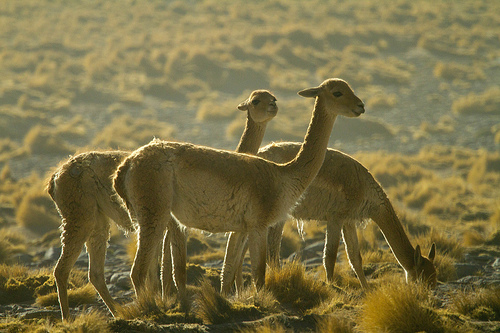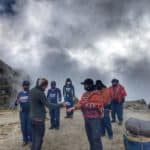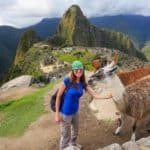You may catch a rare glimpse of a herd of vicuñas on your next Peru trek. Who could help but love this nimble golden camelid that roams the altiplano and mountainous regions of Peru? Sighting their graceful, delicate forms on the run across the high plains while trekking in Peru is a thrilling experience. No wonder they were respected and protected by the Inca. In fact, it was illegal for anybody but members of the ruling family to wear garments made from vicuña wool.

The extremely soft, warm wool of the vicuña is the most coveted fiber in the world! A single overcoat manufactured from vicuña wool goes for upwards of $30,000 USD. Since harsh dyes can damage the fibers, vicuña wool is usually left in its natural state. Additionally, vicuña wool is scarce: each animal only produces around a pound of wool per year.
The vicuña are a highly protected species in Peru. While their population now exceeds 200,000 animals, this was not always the case. Fifty years ago, their numbers had declined to less than 6,000 animals, due to extensive hunting. The Pampas Galeras Reserve was established to protect the vicuña, and its successful breeding and preservation programs literally brought the vicuña back from the verge of extinction. Now, the only legal vicuña fiber is that which is sheared during the annual roundups. Hunting, interfering with, or exporting vicuña is highly illegal in Peru.

Unlike their descendant, the domestic alpaca, the legendary sylphlike vicuña cannot be easily imprisoned or tamed. When kept in captivity, vicuña have been known to develop health issues, such as parasites, osteomyelitis, and dandruff, which damages their wool. Since they are not domesticated or kept in enclosures, vicuñas are herded together yearly in a ceremonial event called a chaccu, during which they are rounded up, sheared, and released back into the wild to roam the plains once more.

Chaccus take place yearly in June on the Pampas Galeras National Reserve in the Lucana province of Peru’s Ayacucho region, on the high altiplano, or mountain plains, where the vicuña live. A grand festival including Peruvian typical music, dancing in colorful traditional garb, and feasting on Peruvian typical dishes accompanies the chaccu. This is the time of the Winter Solstice celebration, an important holiday for the indigenous communities of Peru.
Want to join in on the fun? A trip to the Pampas Galeras to attend the chaccu can be combined with a visit to the Nazca region; it’s an approximate three-hour drive from Nazca to Ayacucho. During your visit, you’ll have the chance to tour the reserve and learn about the community-based programs in place to protect this graceful, golden camelid.
Have you ever wondered about Peru’s other camelids, discover the difference between a llama and an alpaca!
Though rare, vicuñas may occasionally be spotted on one of Apus Peru’s remote Peru mountain treks, which explore the rarely visited backcountry of Southern Peru’s high mountains. See these links for further information:
https://www.apus-peru.com/treks/ausangate_5days.html
https://www.apus-peru.com/treks/ausangate_sibinacocha.htm
It’s a privilege to get the rare view of this legendary, ethereal creature. May the vicuña thrive and continue to grace the Pachamama with their wildness and beauty!










